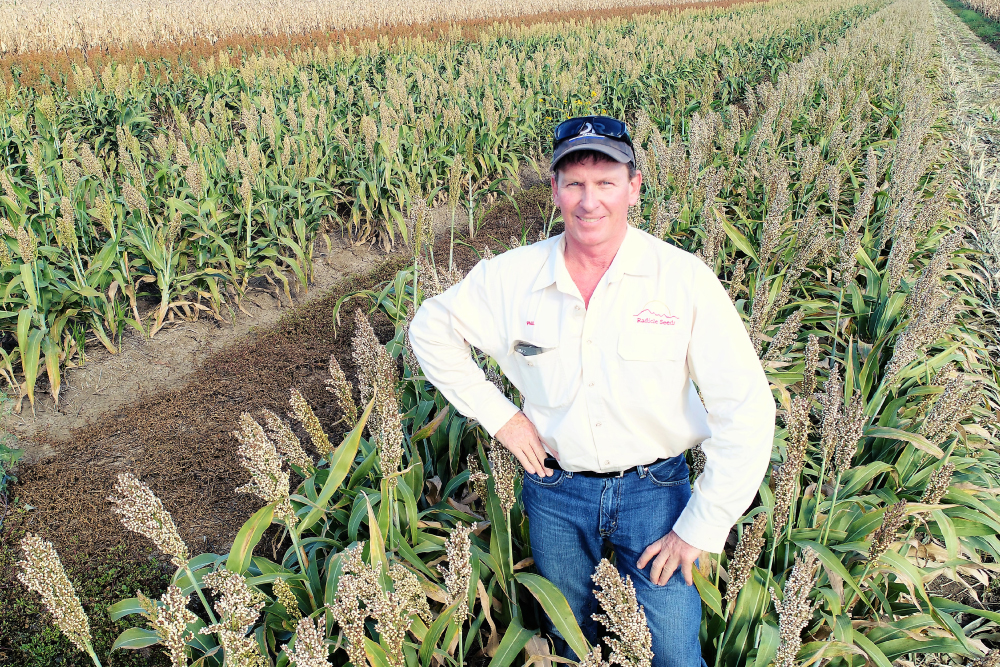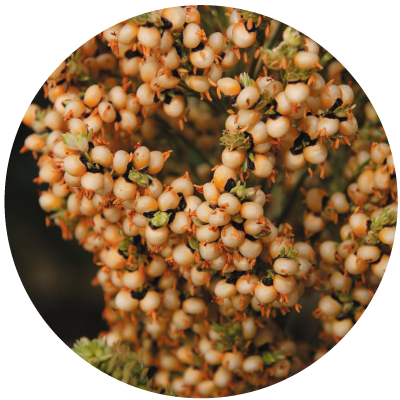From the lab to the paddock, organic grower Paul Murphy says genetic improvements have recast sorghum as a more productive and profitable option for his farm business.
“We haven’t delivered sorghum containing more than four per cent pinched grain for the past five years, and I think that is certainly because of genetic gains in sorghum.” - Paul Murphy, CEO, Radicle Seeds.

Research over the past 20 years has delivered a lift in long-term average yields and grain quality on Mr Murphy’s 2000-hectare property in Queensland’s Central Highlands region. He farms with his family in a marginal cropping area 40 kilometres south-east of Capella.
The combined yield and quality benefits stem from genetic traits developed through the sorghum program at the University of Queensland and the Queensland Department of Agriculture and Fisheries, now delivered through QAAFI at the Hermitage Research Facility in Warwick.
In particular, Mr Murphy says resistance to midge pests now bred into modern sorghum cultivars has prevented midge-related yield losses of almost 40 per cent on his property.
“In past situations where we staggered our sorghum planting using cultivars susceptible to midge, we found there was no seed in the heads of late-sown plants,” he said.
Since making the switch to midge-resistant varieties, however, he estimates yield losses caused by the insect have declined to just five per cent of the crop.
Such genetic resistance is an important consideration for the Murphys because the farm’s certified organic status precludes them from using insecticide to control the mosquito-like pest.
The stay-green trait is another example of genetic improvement that has “made sorghum a more reliable crop”. Mr Murphy says there are fewer crop failures, leading to higher average long-term yields.
Sorghum plants with the stay-green trait maintain green leaves and stems when water is limited during the grain-filling period. This results in higher grain yield, larger grain size and increased lodging resistance with no cost or yield loss in favourable environments.
The stay-green drought-resistance trait has made Mr Murphy’s crop better able to withstand moisture stress and lodging – a key consideration for the mainstay summer crop, which accounts for one-third of the family’s cropping program.
Stay-green has also helped boost overall grain quality in terms of seed size and appearance. “Without the benefit of stay-green, drought-stricken plants tend to produce grain that is pinched or smaller in size,” Mr Murphy said.
“This is difficult to process because it is prone to cracking and has less nutritional value.
“From a visual perspective, large, plump grains are easier to market, especially in high-value export markets for baijiu (sorghum wine).”
Putting the profitability of the stay-green edge into perspective, Mr Murphy said standard grain quality could mean being paid $400 a tonne instead of $500 a tonne in premium organic markets. It has also allowed his family’s enterprise to avoid a price penalty of up to $40/t incurred for organic grain containing more than eight per cent pinched grain.
“We haven’t delivered sorghum containing more than four per cent pinched grain for the past five years, and I think that is certainly because of genetic gains in sorghum,” Mr Murphy said.
Paul is also seeing the benefits of a new hybrid cultivar, Agitator, which he has been growing on his property for the past two years. It has been produced by the grower-owned seed company Radicle Seeds Australia, using genetic material licensed to it from QAAFI.
Mr Murphy is the chief executive officer of Radicle Seeds and says this low-tillering cultivar has two main advantages: high yield potential and climatic resilience.
“Reduced tillering means the plant doesn’t grow extra vegetative biomass so it can channel more of its energy into grain production. The pre-breeding program has tested these tough, low-tillering lines as part of its trial program and provided data on parent lines, which we then use to commercially develop hybrid sorghum cultivars through Radicle Seeds Australia.”
Looking to the program’s future, Mr Murphy says sorghum germplasm to decrease lodging and deliver resistance to charcoal rot disease are high on his wish list.
Queensland’s sorghum success story
 Of all the world's cereal crops, productivity gains in Australian sorghum are unparalleled, and the industry's growth ranks among the highest globally.
Of all the world's cereal crops, productivity gains in Australian sorghum are unparalleled, and the industry's growth ranks among the highest globally.
This success is due to Queensland’s world-class genetic improvement program at the Hermitage Research Facility in Warwick.
Funded by the Queensland Department of Agriculture and Fisheries (DAF), the Grains Research and Development Corporation (GRDC), and UQ, the sorghum genetic improvement program has delivered a cost-benefit of $8.90 for every $1 invested in sorghum RD&E.
Underpinning the program’s success is the link between integrated research drawing on a range of scientific disciplines, such as plant physiology, molecular biology and entomology, and collaboration with the private sector.
Every grain of Australia’s sorghum crop contains at least some elite germplasm bred by this group.
Average sorghum yields increased from about 2 to 3.5 tonnes per hectare between 1996 and 2015.
Sorghum is the main summer grain crop grown for most Queensland regions, and plays a key role in providing feed grains to the beef, dairy, pig and poultry industries.
New markets are opening for Australian sorghum in China to make Baijiu, the world’s top selling liquor and with its gluten free status, demand is increasing for the product in the human health food markets.
The program has licenced nearly 3000 sorghum lines to the global sorghum industry since 1989 – around 10 times the amount of plant breeding material than all the other public sorghum breeding programs around the world combined.
The next steps in the research effort aim to develop a suite of adaptive traits for better root architecture, water use efficiency, heat tolerance and grain quality.



